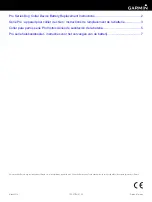
5
/
8
10
Charging WIWE’s accumulator
Connection of the AC adapter may influence the precision of the measurement, therefore
please do not perform measurement when
the device’s accumulator is being charged.
WIWE’s battery can be charged through the USB plug on the bottom of the device with
a USB cable.
Charging WIWE’s accumulator from an electric power source can only be performed with the USB cable supplied with the delivery
or with a regular electronic device.
Use a commercially available USB power supply appropriate to the IEC 62684-2011-01 standard to charge the WIWE.
o
The leftmost LED of the LED line on the top of the device is glowing red whilst the device is charging.
o
The accumulator is fully charged when the red LED light is out. The device can be unplugged.
o
Any charging disturbances (eg. accumulator wears out) are indicated by the charger indicator LED blinking.
The accumulator can be charged any time; it is not necessary to wait until it goes dead.
With normal operating circumstances, the USB charger provides 5V DC voltage. The voltage range of the USB port is 4.45 – 5.25 V
DC. Current consumption of the WIWE charging unit during charging max.: 280mA.
WIWE is a low-voltage device, general safety rules that apply to electric household appliances must be adhered to when charging the
accumulator.
The lifespan of the accumulators is limited. WIWE’s accumulator cannot be changed. You can find how much time it takes for the
accumulator to go dead at the device’s technical information.
11
After usage
The device automatically shuts down after use, but you can also turn it off with the ON/OFF button.
After use, clean the electrodes with soft and dry cloth, if necessary.
When WIWE is used by someone other than its owner, the sensors need to be cleaned which can be done with a wet, antiseptic
cloth if anybody other than the owner uses it. After this you need to wait for the device to dry completely before you use it again.
12
Potential problems and troubleshooting.
1.
It is very unlikely for WIWE to malfunction. However, if you experience any functional failures, you can find information
on the possible solutions at www.myWIWE.hu, www.myWIWE.com website.
2.
You may ask questions at [email protected] e-mail address, too.
3.
The device does not require any special handling.
13
Storage requirements
Do not use and do not store WIWE in a moist room, and in places where it could get in contact with water.
Do not use and do not store WIWE where there is extreme air pressure, temperature or high humidity; rooms with poor ventilation,
air that is dusty, salty or sulfuric, or where chemical substances may get into the air, and where gas leak could occur.
Do not expose the device to radiant heat.
14
Safety requirements
14.1
Ensuring electromagnetic compatibility
Electronic appliances such as mobile telecommunication device radiation may disturb the operation of WIWE, therefore always
consider the signals indicating electromagnetic compatibility (EMC, electromagnetic compatibility) of devices around WIWE and use
them accordingly.
WIWE conforms to IEC 60601-1-2 international standard of medical electrical equipment and systems electromagnetic tolerance,
however, if the electromagnetic environment exceeds the limits set by IEC60601-1-2, it could disturb the operation of WIWE to the
extent that partial or complete loss of function may occur. That is why the source of disturbance nearby needs to be found and
eliminated (within 1m range) before the loss of function or malfunction occur, before continuing to use WIWE.
14.2
Countermeasures to be applied in case sources of disturbance frequently occur:
Heavy electromagnetic disturbance caused by a nearby source of disturbance (eg. radio, other electronic appliance). If the source
cannot be eliminated, use WIWE in another room. In all other cases, you have to make sure that source of disturbance eg. household
electric appliances, is not used near WIWE. Keep at least 30cm distance between the source of disturbance and WIWE!
Impact of direct or indirect electrostatic discharge:
Before use, make sure that the user and the immediate vicinity of the user are free of electrostatic energy. Proper air humidity and
antistatic flooring may decrease the risk for electrostatic discharge.
15
Maintenance and checks
WIWE had been calibrated by the manufacturer, there is no need for further calibration. With proper use, the system does not need
any kind of maintenance.
Before use, please check the integrity of the device. Do not use a damaged device and do not charge its accumulator.
WIWE must not be changed in any way.
In case of malfunction or incorrect functioning, the distributor must be informed.
Any repairs can only be performed by the manufacturer or the person or company appointed by the manufacturer.
16
Waste management and liquidation
According to the ordinance of hazardous electronic wastes, broken WIWE devices must be placed in special containers suitable for
wastes like this and maintained for this purpose!
It cannot be placed amongst household waste!
If the device suffers a malfunction or damage that cannot be recovered, or the user decides to destroy the device for any other reason,
it must be handled as hazardous waste, and therefore can only be handed over to appropriate collection sites.
17
Important legal information
Descriptions, suggestions and any other information about WIWE, illustrations and any other references had been provided with great
care, based on practical and experimental results and experiences. Nevertheless, Sanatmetal Ltd. will not be liable in any way for
damages deriving from the application of descriptions, suggestions or illustration. The manufacturer is unable to supervise whether


























